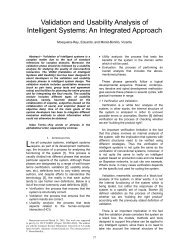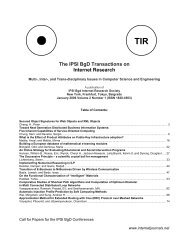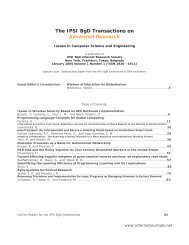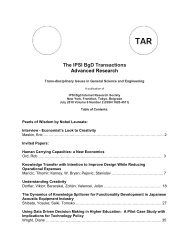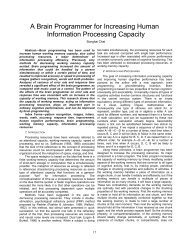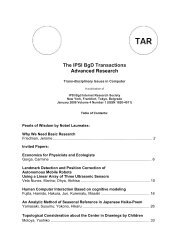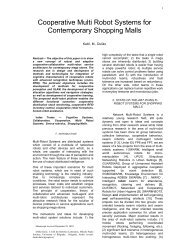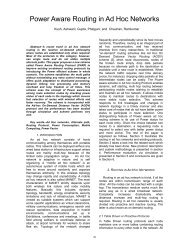The Xmath Partial Differentiation Algorithm
The Xmath Partial Differentiation Algorithm
The Xmath Partial Differentiation Algorithm
Create successful ePaper yourself
Turn your PDF publications into a flip-book with our unique Google optimized e-Paper software.
REPLACE THIS LINE WITH YOUR PAPER IDENTIFICATION NUMBER (DOUBLE-CLICK HERE TO<br />
EDIT) <<br />
1<br />
<strong>The</strong> <strong>Xmath</strong> <strong>Partial</strong> <strong>Differentiation</strong> <strong>Algorithm</strong><br />
Odd Bringslid<br />
Abstract—<strong>The</strong> <strong>Xmath</strong> eBook is being<br />
developed and algorithms into a wide range<br />
of undergraduate mathematical issues<br />
embeded in Mathematica packages are<br />
available on the web using the system<br />
webMathematica. <strong>The</strong> main purpose is to<br />
visualize mathematics in the same way as<br />
would a professor do it on the blackboard<br />
stating all intermediate steps for user defined<br />
input and then presenting solutions being<br />
easily recognized by the undegraduate<br />
student which may not always be the case<br />
using the Mathematica system directly. In this<br />
way the student may work more on a personal<br />
basis, viewing one step at a time in the<br />
solving process and then being less<br />
dependent of the professors. In this paper<br />
<strong>The</strong> <strong>Xmath</strong> <strong>Algorithm</strong> for <strong>Partial</strong><br />
<strong>Differentiation</strong> step-by-step are presented (PD<br />
Steplet)<br />
Index Terms— <strong>Partial</strong> <strong>Differentiation</strong> (PD),<br />
Steplet, Mathematica packages, Online<br />
calculations, Pedagogical value<br />
T<br />
1. INTRODUCTION<br />
he use of Mathematica [1] in education is one<br />
of the most important areas of application.<br />
<strong>The</strong> problem however is that in education we are<br />
focusing on how problems are solved perhaps<br />
more than on the final result. Since Mathematica<br />
only gives the final result it will be necessary to<br />
build an application on top of Mathematica giving<br />
intermediate results using the methods of solving<br />
given by mathematical textbooks. It is necessary<br />
to analyze the equations in depth, <strong>Xmath</strong> then<br />
using the Mathematica object TreeForm to be<br />
able to extract the information needed at each<br />
level of the solution process. <strong>The</strong> algorithm is<br />
different from the algorithm used by the<br />
developers of the Mathematica System (D).<br />
<strong>The</strong> <strong>Xmath</strong> algorithm will solve problems typical<br />
in mathematical teaching. General partial<br />
differentiation is implemented using standard<br />
methods, tracking the solving process in detail to<br />
be easily recognized by the students.<br />
<br />
Manuscript received 2010. Author, assoc. prof. Odd Bringslid<br />
is with the Institute of technology, Buskerud University College,<br />
Norway (odd.bringslid@hibu.no)<br />
2. PEDAGOGICAL VALUE<br />
<strong>The</strong> pedagogical value of the <strong>Xmath</strong> algorithms<br />
lies in the fact that a student may simulate solving<br />
by changing parameters and type of function. <strong>The</strong><br />
important thing is that <strong>Xmath</strong> solves the<br />
equations as would a professor do it on the<br />
blackboard then easily being recognized by the<br />
students which is not the case using the<br />
Mathematica system directly [2].<br />
Level 1<br />
3. EXAMPLE<br />
Find the partial derivative<br />
Quotient Rule<br />
u ∂u<br />
∂v<br />
∂ v − u<br />
v ∂y<br />
∂y<br />
=<br />
2<br />
∂y<br />
v<br />
2 2<br />
Here u sin( x y) and v x y , Finding derivatives of u and v<br />
Level 2<br />
= ⋅ = +<br />
∂ sin( x ⋅ y)<br />
Find the partial derivative<br />
∂y<br />
Chain Rule, Composite function<br />
Substitute u = g( y)<br />
∂f ( g( y))<br />
∂f ∂u<br />
= ⋅<br />
∂y ∂u ∂y<br />
Inside function u = x ⋅ y and outside f ( u) = sin( u)<br />
Level 3<br />
∂ sin( x ⋅ y)<br />
( )<br />
2 2<br />
∂ y x + y<br />
∂( x ⋅ y)<br />
Find the partial derivative<br />
∂y<br />
Linear Rule, Constant factor
REPLACE THIS LINE WITH YOUR PAPER IDENTIFICATION NUMBER (DOUBLE-CLICK HERE TO<br />
EDIT) <<br />
2<br />
∂( c ⋅ f ) ∂f<br />
= c ⋅ , Here c = x and f ( y)<br />
= y<br />
∂y<br />
∂y<br />
Finding the derivative of the non − constant factor f ( y)<br />
=<br />
Level 4<br />
2 2 2 2<br />
∂ ( x + y ) ∂x ∂y<br />
= +<br />
∂y ∂y ∂y<br />
Level 3<br />
Find the partial derivative<br />
Power Rule<br />
n<br />
∂y<br />
∂y<br />
∂ y = 1<br />
∂y<br />
n−<br />
= n ⋅ y<br />
1 , Here n = 1<br />
∂y<br />
∂y<br />
2<br />
∂x<br />
Find the partial derivative<br />
∂y<br />
Constant Rule<br />
Derivative of a constant is 0 (independent of y)<br />
2<br />
∂x<br />
∂y<br />
= 0<br />
Result, Linear Rule Constant factor<br />
∂( x ⋅ y)<br />
∂y<br />
= x = x<br />
∂y<br />
∂y<br />
∂ u = x<br />
∂y<br />
Finding the dervative of the outside function<br />
Level 3<br />
Find the partial derivative<br />
Sin Rule<br />
∂ sin( u)<br />
= cos( u)<br />
∂u<br />
∂ f = cos( u)<br />
∂u<br />
∂ sin( u)<br />
∂u<br />
Result, Linear Rule Sum<br />
2 2 2 2<br />
∂ ( x + y ) ∂y ∂x<br />
= + = 2y<br />
∂y ∂y ∂y<br />
∂v<br />
∂v<br />
This gives = 2y and u = 2y sin( x ⋅ y)<br />
∂y<br />
∂y<br />
in the second part of numerator of the rule.<br />
We then find the numerator :<br />
∂u<br />
∂v<br />
v − u = x x + y x ⋅ y − y ⋅ sin x ⋅ y<br />
∂y<br />
∂y<br />
Result, Quotient Rule (Answer)<br />
sin( x ⋅ y)<br />
∂u ∂v<br />
∂ v − u<br />
2 2<br />
x + y ∂y ∂y<br />
= =<br />
2<br />
∂y<br />
v<br />
2 2<br />
( )cos( ) 2 ( )<br />
x x y x y y x y<br />
2 2 2<br />
( x + y )<br />
2 2<br />
( + )cos( ⋅ ) − 2 sin( ⋅ )<br />
Result, Chain Rule<br />
Substitute u = g( y)<br />
= x ⋅ y<br />
∂ sin( x ⋅ y) ∂( g( y))<br />
∂f ∂u<br />
= = = x ⋅cos( x ⋅ y)<br />
∂y ∂y ∂u ∂y<br />
∂u<br />
∂u<br />
This gives = x ⋅ x ⋅ y and v = x x + y x ⋅ y<br />
∂y<br />
∂y<br />
Level 2<br />
Find the partial derivative<br />
Linear Rule, Sum<br />
2 2<br />
cos( ) ( )cos( )<br />
∂ +<br />
∂y<br />
2 2<br />
( x y )<br />
4. THE LINEAR RULE<br />
<strong>The</strong> linear rule will differentiate a function like<br />
(1) f ( x , x ,..) = a f ( x , x ,..) + a f ( x , x ,..) + ...<br />
1 2 1 1 1 2 2 2 1 2<br />
Here a<br />
i is independent of x. <strong>The</strong> rule is divided<br />
into the linear rule sum and the linear rule<br />
consant factor.
REPLACE THIS LINE WITH YOUR PAPER IDENTIFICATION NUMBER (DOUBLE-CLICK HERE TO<br />
EDIT) <<br />
3<br />
<strong>The</strong> function is broken down for analyzing by<br />
using the Mathematica object TreeForm [3] with 2<br />
levels. <strong>The</strong> Mathematica object D [4] gives the<br />
derivative. Linear rule sum:<br />
LinearList=Reverse[Level[TreeForm[f],2]];<br />
LinearList=Delete[LinearList,1];<br />
Do[Main[ak*yk,level],{j,1,Length[LinearList]}]<br />
] (*end Do*));<br />
Result=Sum[Main[ak*yk]]<br />
Figure 1 PseudoCode Linear Rule Sum<br />
FactList=Reverse[<br />
Level[TreeForm[a*y[x]],2]];<br />
If [ FreeQ[FactList[[3]],x],<br />
Result=FactList[[3]] * Main[FactList[[2]],x,level]]<br />
Figure 2 PseudoCode Linear Rule Constant Factor<br />
Head[expr]===Plus,DPlusRule[expr,x,level]<br />
Head[expr]===Times&&(Not[FreeQ[Denominator[<br />
k[[2]]],x]]<br />
ν Not[FreeQ[Denominator[k[[3]]],x]]),<br />
DQuotRule[expr,x,level],<br />
Head[expr]===Times&&FreeQ[Last[k],x] ν<br />
FreeQ[k[[2]],x],DProdCoRule[expr,x,level],<br />
Head[expr[===Times, DProductRule[expr,x,level],<br />
Head[expr]===Power&&k[[3]]===x&&FreeQ[k[[2]],x],DPower<br />
Rule[expr,x,level],<br />
Head[expr]===Power&&FreeQ[k[[2]],x],DChainRule[expr,x,lev<br />
el],<br />
Head[expr]===Power&&Head[k[[2]]]===Symbol&&FreeQ[k[[3]<br />
],x],<br />
DDPowerRuleExp[expr,x,level],<br />
5. THE QUOTIENT RULE<br />
<strong>The</strong> quotient rule will differentiate a function like<br />
u( x , x ,...)<br />
(2) f ( x , x ,...) =<br />
1 2<br />
1 2<br />
v( x1, x2,...)<br />
expr=u/v;<br />
u=Numerator[expr];<br />
v=Denominator[expr];<br />
Result=Main[D[u,x]*v-D[v.x]*u)/v^2,level];<br />
Figure 3 PseudoCode QutientRule<br />
6. CHAIN RULE<br />
This rule is used for a function being a composite<br />
function of the form y=f (g(x)). <strong>The</strong> derivative is<br />
given by the chain rule<br />
u = g( x)<br />
∂f ( g( x)) ∂f ( u)<br />
∂u<br />
= ⋅<br />
∂x ∂u ∂x<br />
expr=g[u[x]];<br />
u=Reverse[Level[TreeForm[g[u[x]], 2]];<br />
Result=Main[D[expD[g[u],u]*D[u[x]];<br />
Figure 4 PseudoCode ChainRule<br />
MAIN PROGRAM<br />
PseudoCode given for rules used in the eaxmple.<br />
Main[expr,x,level]:=Module[{},<br />
k=Reverse[Level[TreeForm[e …)xpr,2];<br />
Which[<br />
FreeQ[expr,x],DConstantRule[expr,x,level],<br />
expr===x,DxRule[expr,x,level],<br />
Head[expr]===Tan,<br />
If[Last[k]===x,DTanRule[expr,x,level],DChainRule[expr,x,level<br />
]],<br />
(* Same system for<br />
Cos,Sin,Log,Arctan,ArcSin,ArcCos*)<br />
FreeQ[k[[3]],x]&&Head[expr]=Power,DChainRuleExp[expr,x,le<br />
vel],<br />
Head[expr]==Power&&Not[FreeQ[k[[2]],x]],<br />
LogarithmicRule[expr,x,level]<br />
]<br />
Figure 5 PseudoCode Main Program<br />
<strong>The</strong> Main Program invokes the Mathemaica objects<br />
FreeQ [5], Head[6], Which[7] and Reverse [8]<br />
ACKNOWLEDGMENT<br />
Acknowledgements are expressed to the<br />
partners of the EU projects <strong>Xmath</strong> [9] and dMath<br />
[10].<br />
REFERENCES<br />
[1] Wolfram Research, http://www.wolfram.com/<br />
[2] Bringslid, Odd, Norstein, Anne (2008), Teaching<br />
Mathematics using Steplets. International Journal of<br />
Mathematical Education in Science and Technology<br />
39:7 pp 925-936<br />
[3] Wolfram Research, <strong>The</strong> Mathematica Book (2003) pp<br />
236-237<br />
[4] Wolfram Research, <strong>The</strong> Mathematica Book (2003) pp<br />
80<br />
[5] Wolfram Research, <strong>The</strong> Mathematica Book (2003) pp<br />
124<br />
[6] Wolfram Research, <strong>The</strong> Mathematica Book (2003) pp<br />
231<br />
[7] Wolfram Research, <strong>The</strong> Mathematica Book (2003) pp<br />
345<br />
[8] Wolfram Research, <strong>The</strong> Mathematica Book (2003) pp<br />
127<br />
[9] <strong>Xmath</strong> project (http://dmath.hibu.no/xmath/)<br />
[10] dMath project (http://dmath.hibu.no)<br />
Odd Bringslid<br />
Assoc. Professor at <strong>The</strong> Institute of Technology, Buskerud<br />
University College, Norway. Project coordinator of EU<br />
Leonardo project dMath [1], EU Minerva project <strong>Xmath</strong> [4]<br />
and a former third party program designer for HP calculators.
REPLACE THIS LINE WITH YOUR PAPER IDENTIFICATION NUMBER (DOUBLE-CLICK HERE TO<br />
EDIT) <<br />
4<br />
Officially appointed as Project leader of Educational<br />
Government Projects. Partner in the JEM project. Conference<br />
leader of several European Conferences into eLearning.<br />
Guest Editor of the Journal of Computers in Mathematics and<br />
Science Teaching. Research into mathematical eLearning<br />
and Computer Algebra and proposed Member of the<br />
OpenMath Society.



